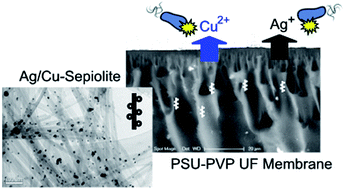Antimicrobial organic–inorganic composite membranes including sepiolite-supported nanometals†
Abstract
In this study, composite polysulfone–polyvinylpyrrolidone (PSU–PVP) membranes were prepared using silver and copper loaded sepiolite as a filler. Metal-loaded sepiolite was evenly dispersed within the membranes. No leaching of metal particles was observed during use and only dissolved metals were responsible for membrane antimicrobial activity. The membranes displayed high antibacterial activity showing surfaces free of bacterial colonisation (<20 CFU cm−2). Escherichia coli was inactivated at a higher rate (below detection limit in less than 60 min for silver sepiolite loaded membranes) than Staphylococcus aureus. All membranes could be successfully reused after daily inoculations and subsequent washing allowing up to 20 cycles with <99.999% CFU removal. The silver leached daily represented ≅0.2–0.4% of the total initial silver content of membranes (0.8–1.0% for copper in copper-containing membranes). Despite its initial lower rate of inactivation, the resistance to S. aureus colonisation lasted longer than that to E. coli in an assay consisting of daily inoculations on the same membranes.



 Please wait while we load your content...
Please wait while we load your content...